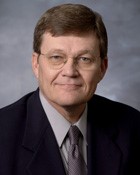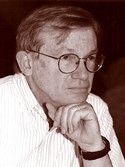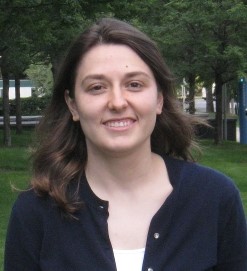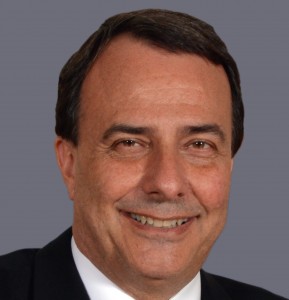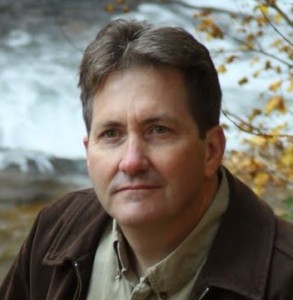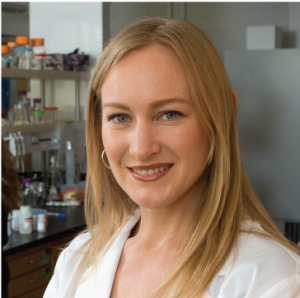Jump to a presenter:
David H. Bailey
Richard N. Williams
John S. Lewis
Ron Hellings
Bart J. Kowallis
Jani Radebaugh
Amy L. Williams
Jeffrey M. Bradshaw
Steven L. Peck
Michael R. Stark
Emily Bates
R. Paul Evans
Trent D. Stephens
Bio: David H. Bailey is a computer scientist and mathematician, recently retired from the Lawrence Berkeley National Laboratory in Berkeley, California, also affiliated with the University of California, Davis. His published works include over 160 papers and four books. He is the recipient of the Fernbach Award from the IEEE Computer Society, the Gordon Bell Prize from the Association for Computing Machinery, and the Chauvenet Prize from the Mathematical Association of America. He has also written articles on science and religion, and on science and Mormonism in particular. He is the editor of the sciencemeetsreligion.org website.
Bailey grew up in Provo, Utah, and is a fourth-generation Latter-day Saint, descended from the second convert to be baptized in the British Isles. He served a full-time mission for the LDS Church in Hong Kong, and participated in the translation of the Doctrine and Covenants into Chinese. He and his wife live in Alamo, California.
For further information, see http://www.davidhbailey.com
Abstract: Science vs. Religion: Can This Marriage Be Saved?
Science plays a major role in modern society, and religion plays a similarly important role in the lives of people worldwide. It is thus with great sadness that many of us witness the ongoing “war” between the two camps. On one side, writers (mostly from secular and scientific backgrounds) argue that religion is not only utterly unscientific, but that it is also responsible for war, ignorance, intolerance and the repression of women. On the other side, writers (mostly from fundamentalist religious backgrounds) argue that much of modern science is not only in error, but that it is also responsible for promiscuity, drug abuse and the general decline of society. The scholarship on both sides is often of rather poor quality, and is not published in peer-reviewed academic journals.
Thus many thinking people are asking: Can this marriage be saved? The speaker will argue that yes, this marriage can be saved, but only if both sides recognize that, while all truth may ultimately be attained, in our current state of ignorance both sides must humbly recognize their limitations and respect the other domain. After all, modern science is the most powerful tool known to explore the physical laws and processes that govern the universe. Yet it can say next to nothing about morality, salvation, ethics or the ultimate meaning of life, nor were its methods ever designed to probe such fundamental questions. Similarly, religion through the ages has addressed morality, salvation, and the purposes of existence, and is a powerful force for mutual understanding and charity worldwide, but scriptures alone provide no clues as to the mass of the electron or the equations of general relativity, nor were they ever intended to be read in such a technical sense.
Yet science and religion (the LDS religion in particular) have much in common: an eternal quest for truth, the “idea of progress,” and a reverence for the elegant laws that govern the universe. One uniquely LDS perspective here is its traditional teaching that God works within the realm of natural law, and that there are no “miracles” that transcend natural law — thus largely eliminating the need for a “war” between science and religion. And both science and religion can stand in awe at the majesty of the universe, which is now known to be much vaster, more intricate and more magnificent than ever before realized in human history.
Bio: Richard N. Williams received his Ph.D. in Psychological Sciences from Purdue University. He is a Professor of Psychology and currently Director of the Wheatley Institution at Brigham Young University. His scholarly interests include the conceptual foundations of psychological theories and the relationship between traditional and postmodern perspectives. Related to this topic, he has written What’s Behind the Research: Discovering Hidden Assumptions in the Social Sciences (with Brent Slife), Sage Press, 1995, and edited (with Edwin Gantt) Psychology for the Other, Duquesne University Press, 2002, He has published in various scholarly journals, most recently, “Moral obligation and the moral judgment-moral action gap: Toward a phenomenology of Moral Life, Journal of Moral Education, 41(4), 417-435 and Psychology and the death of aspiration. Theory and Psychology. 23(2), 184-204, both with Edwin E. Gantt.
Abstract: Science, Religion, and Agency
Almost all conceptions of human agency are rooted in libertarianism and grounded in a set of assumptions about the nature of the non-human world, the nature of causality, and the nature of determinism. The effect of this is that agency is always understood around two mutually exclusive positions, compatibilism and incompatibilism. Within this intellectual context, human agency is always impossible, trivial, or illusory. Human agency is drawn into discussions of science and religion because most traditional “scientific” notions of causality and determination are understood in ways that make agency impossible, and most religious positions try to reconcile themselves to the classical libertarian position, which is self-contradictory. The presentation proposed here argues for a new understanding of human agency which requires a rethinking of causality and determinism that is compatible with science. And a refutation of agency that most religious positions unwisely endorse. Agency turns out to be not so much a matter of free choice, but of a deeper matter of the nature of the human world, human ontology, and truth. The lack of clarity on issues of science, religion, and agency comes not from science or religion, but from a faulty dogmatic scientism and the naturalistic metaphysic it always imposes on intellectual discourse.
Bio: John S. Lewis is Professor Emeritus of Planetary Sciences and Co-Director of the Space Engineering Research Center at the University of Arizona. He was previously a Professor of Planetary Sciences and Chemistry at MIT. He was a Visiting Associate Professor at the California Institute of Technology in 1973 and a Visiting Professor at Tsinghua University in Beijing, PRC for the 2005-2006 academic year.
His research interests are related to the application of chemistry to astronomical problems, including the origin of the Solar System, the evolution of planetary atmospheres, the origin of organic matter in planetary environments, the chemical structure and thermal history of icy satellites, the hazards of comet and asteroid bombardment of Earth, and the extraction, processing, and use of the energy and material resources of nearby space. He served on the Board of Directors of American Rocket Company (AmRoc) during the development of hybrid rocket motors for the private launch business, a process that culminated in the use of an AmRoc-designed motor to propel SpaceShipOne to an altitude of over 100 km and win astronaut’s wings for its pilots in 2004.
He is presently Chief Scientist for Deep Space Industries, an asteroid-mining company.
He has served as a member or Chairman of a wide variety of NASA and National Academy of Sciences (NAS) advisory committees and review panels, spanning topics ranging from planetary exploration and the origin of life to interstellar communication. He has written 19 books, including graduate and undergraduate texts and popular science books, and has authored over 150 scientific publications and has given invited lectures at over 100 colleges, universities, and research centers throughout the world.
He and Sister Lewis are converts who joined the Church in 1981. They served for a year at Tsinghua University in Beijing through BYU’s China Teachers Program, and served as missionaries for 18 months in the International Zone of the Family History Library in Salt Lake City. They have recently received a call to return to mission service in the New Zealand Wellington Mission in October of this year. They have six children and 32 grandchildren. Their granddaughter Amber is now serving in the Nova Scotia Halifax Mission.
Further information available at:
https://churchofjesuschrist.org/pages/we-lived-with-god?lang=eng
http://www.mormonscholarstestify.org
Google: “John S. Lewis” (with quotes)
Contact: jsl (at) U.Arizona (dot) edu
Abstract: The Scale of Creation in Space and Time
Points: The accounts of creation in Genesis, Moses, and Abraham, as well as in higher endowments of knowledge given to the faithful, are based on visions in which the seer lacked any modern knowledge and vocabulary to describe and interpret what he saw. Attempts to express the content of these visions frequently make assumptions that assume modern concepts that were completely at odds with the understanding of ancient peoples.
- The spatial extent of creation: Genesis is often read as a description of the origin of the Universe rather than the Earth. But ancient views of the cosmos had no concept of anything remotely similar to our modern sense of the word: Earth was the only material body; everything else was spiritual or celestial and perfect in nature; “perfect” meant perfectly spherical and featureless; the number 7 was perfect, so there must be precisely 7 “heavenly bodies” (Sun, Moon, Mercury, Venus, Mars, Jupiter, and Saturn) of which the base and material Earth was NOT a member; these seven wanderers traveled about Earth in inscrutable patterns; Earth was not so much the “center of creation” as the only material body in creation; the “heavens” were the sky as seen from Earth’s surface with the naked eye; the “firmament” was a solid (firm) dome surrounding our little kosmos; the “fixed stars” were not even heavenly bodies—through medieval times they were usually thought of as holes in the firmament that admitted light from the celestial realms above; aberrant sights in the heavens were not “real” (material) but signs sent by God. If the word “universe” were defined to an ancient as “everything that exists” he would immediately understand that to mean Earth, and, if spiritually inclined, he would include the seven celestial wanderers as well.
- The time scale of creation: Fundamentalist sources typically take the word “day” in Genesis to be literally one modern Earth day, even though such days did not exist until “day” 3. We have been told that these were “creative periods” that were called “days” as a convenient, albeit figurative, label. Moreover, LDS sources since Joseph Smith’s King Follett discourse have repeatedly expressed the time scale for the Earth as billions of years, beginning long before scientists dared suggest the same conclusion. Remarkably, this number was arrived at as an interpretation of the Genesis creation story. We will see how Joseph Smith’s number of 2.555 billion years was derived and compare it to current radioisotope chronologies of Earth, Moon, Mars, and asteroids.
- Creation as an ongoing process vs. a magical instant: LDS scripture, beginning with the Book of Moses, portrays creation as diachronic; many worlds came into existence before Earth existed and many no longer exist; creation continues to the present. President Snow’s couplet saying that God once lived in mortality on a world similar to ours also requires that generations of planets pre-existed Earth. The laws of nature, on which the formation, evolution, and death of worlds over lifetimes of billions of years are predicated, must have been in existence long before the formation of our planet. Thus the origins of the Universe and of Earth were widely separated events. The origin of Earth and the rest of the Solar System 4.55 billion years ago occurred in the context of a collapsing interstellar cloud, just as we see today in the Orion Nebula and elsewhere, accompanied by the simultaneous formation of thousands to millions of other stars and planetary systems in a “starburst”. The origin of the Universe 13.6 billion years ago was 9 billion years in the past when Earth appeared.
Bio: Ron Hellings was born and raised in Pasadena, California. After serving 2 1/2 years in the French East and Franco-Belgian missions, he returned to marry his sweetheart, Dee, and complete a BS in Physics at BYU, an MS at UCLA, and a PhD at Montana State University-Bozeman. He has taught Physics at Southern Oregon University, University of Nevada-Las Vegas, Cal Poly-Pomona, and Harvey Mudd College. Ron spent twenty-five years as a Research Scientist at NASA’s Jet Propulsion Laboratory before moving back to Bozeman in 2001 to work as a Research Professor in the Physics Department at MSU. For a period of three years during this time, he was actually on loan to NASA Headquarters in Washington DC to act as Program Scientist for the Astrophysics Theory Program. His research interests are alternative theories of gravity, experimental relativity, solar system dynamics, gravitational wave astronomy, pulsar timing, and relativistic cosmology. In the Church, Ron is basically a Gospel Doctrine teacher, having spent a total of 25 years in that calling in various wards. He has also recently served as bishop of the Bozeman University Ward. Ron and Dee have three married children and four grandchildren.
Abstract: Joseph Smith and Modern Cosmology
Analysis of the written and spoken words of Joseph Smith reveals that he had a consistent view of the nature of God and the universe, one very much at odds with the views of the current religions of his day. In particular, Joseph taught of an infinite and eternal universe of matter, matter that was not and could not be created or destroyed, and that there was thus no first cause and no creation ex nihilo. For a few decades of the mid 20th century, Joseph’s ideas were contradicted by contemporary scientific big-bang cosmologies. However, in the last couple of decades, these models have themselves been overthrown, and models satisfying Joseph’s principles are again consistent with observation and theory.
Bio: Bart J. Kowallis is associate dean of the College of Physical and Mathematical Sciences and professor of geology at Brigham Young University. He received a BS degree in geology at BYU and MS and PhD degrees, also in geology, from the University of Wisconsin-Madison. He has taught classes in physical geology, structural geology, field geology, and physical science for more than 30 years. His research and publications focus on geochronology, stratigraphy, and structural geology, particularly of the Jurassic rocks in Utah. He is a fellow of the Geological Society of America and member of several other national geological and genealogical societies. Dr. Kowallis has received an Alcuin General Education Teaching Award, Myron G. Best Excellence in Teaching Award, and Karl G. Maeser General Education Professorship, all from BYU, in recognition of his work with general education and teaching. He and his wife Julee are the parents of four children.
Abstract: From All Eternity to All Eternity: Deep Time and the Gospel
The idea of eternity is an important concept in LDS theology and is widely accepted as truth without questioning its reach from a history stretching back forever into a future sweeping out to infinity. Yet the similar, more restricted idea of “deep time” or, as it is also called, “geologic time,” has troubled not only faithful Latter-day Saints, but other believers in God. In this presentation, we will examine the origins of the idea of deep time, look at the evidence for an ancient age for the earth and universe, discuss the opinions of past religious leaders both within and without the LDS Church on the topic, and conclude with observations and comments on where this concept fits into our theology today.
Bio: Jani Radebaugh, from Orem, Utah, is a planetary scientist who specializes in landform geomorphology in the solar system. She studies more accessible features on Earth to gain insight into similar landforms and processes on other planets. Her current investigations include dunes, mountains, cryovolcanoes, rivers and lakes on Saturn’s moon Titan from Cassini RADAR observations and volcanoes and mountains on Jupiter’s moon Io from Galileo, Cassini, and Voyager observations. She has done field work in the Egyptian Sahara, the Ethiopian Afar Rift Valley, Hawaii, the desert southwestern US, and Antarctica. She obtained her PhD in planetary science from the University of Arizona’s Lunar and Planetary Laboratory, and she is currently an associate professor of geological sciences at Brigham Young University.
Abstract: The Outer Solar System: A Window to the Creative Breadth of Divinity
Prior to the 1970s, we only had images of the surfaces of the planets of the inner solar system, bodies that were either reminiscent of Earth’s deserts, like Mars, or dominated by cratering and volcanism, on Mercury and the Moon. These bodies thus felt more familiar than alien and exotic. Upon the arrival of the Voyager spacecraft to Jupiter, Saturn, Uranus and Neptune there was an awakening to the variety and diversity of bodies that exist in our solar system. Planetary siblings to Earth are known to have sun-like atmospheres with head-sized helium raindrops and interiors with ultra dense hydrogen metal, surfaces of water ice with liquid water oceans that may be friendly to life, rainfall and lakes full of liquid methane, geysers of nitrogen, and lakes of lava the size of Utah Valley. The existence of these bodies proves the creative capacity of deity and demonstrates the importance of beauty and uniqueness within creation. Such discoveries also lead us to turn our minds outwards to the possibilities for diversity, in planets and perhaps their inhabitants, likely beyond our current understanding, in the galaxy and universe.
Bio: Amy L. Williams received PhD (2010) and SM (2005) degrees in Computer Science from MIT and two BS (2003) degrees from the University of Utah in Computer Science and Mathematics. From 2009-2013 she worked as a Postdoctoral Research Fellow at Harvard Medical School studying population and medical genetics, and she began a postdoc at Columbia University in August. Her research interests span the intersection of genetics and computer science, with her primary focus on using large data sets to study haplotype evolution and genetic ancestry among individuals.
Abstract: Answering New Atheism and Seeking a Sure Knowledge of God
Some of life’s most fundamental questions revolve around the nature and purpose of our existence, including the key question: “Is there a God?” The growing New Atheist movement uses analogy, appeals to science, and critique of religion to argue that God does not exist. Yet these arguments, while somewhat persuasive on the surface, offer no proof against God’s existence. In contrast, the fundamental tenets of Mormonism—which include the promise of answers to prayer and of developing a personal relationship with God—suggest that one can obtain direct evidence that God does live. Whereas New Atheism incorrectly asserts that science has shut the door to God, Mormonism offers empirically based belief in God and the opportunity for greater enlightenment through divine inquiry. This talk constructively examines New Atheist arguments and suggests that God’s existence can be directly verified by spiritual means.
Bio: Jeffrey M. Bradshaw (Ph.D., Cognitive Science, University of Washington) is a Senior Research Scientist at the Florida Institute for Human and Machine Cognition (IHMC) in Pensacola, Florida. His professional writings have explored a wide range of topics in human and machine intelligence and their interaction. His research group is currently developing systems addressing human-agent-robot teamwork, cyber defense, digital policy management, semantic technologies, advanced training systems, and healthcare (www.ihmc.us/groups/jbradshaw, http://en.wikipedia.org/wiki/Jeffrey_M._Bradshaw).
Jeff serves as a member of the Board on Global Science and Technology for the National Academies of Science; as an external advisory board member of the Cognitive Science and Applications Program at Sandia National Laboratories; and as chair of the Scientific Advisory Council for the Nissan Silicon Valley Research Center in support of the development of autonomous vehicles. He is an Honorary Visiting Researcher at the Center for Intelligent Systems and their Applications and AIAI at the University of Edinburgh in Scotland and a member of the Graduate Faculty at the Human-Centered Design Institute of the Florida Institute of Technology. With Robert Hoffman and Ken Ford, he serves as co-editor of the Human-Centered Computing Department for IEEE Intelligent Systems and is a co-editor of the recent volume Essays on Human-Centered Computing, along with other publications. In 2011, he received the Web Intelligence Consortium Outstanding Contributions Award.
With David Larsen, Jeff recently finished a second volume of commentary on the book of Moses and the early chapters of Genesis entitled “In God’s Image and Likeness 2: Enoch, Noah, and the Tower of Babel.” His other LDS publications have focused mainly on temple studies and the ancient Near East (www.templethemes.net). Jeff serves as a Vice President of The Interpreter Foundation (interpreterfoundation.org) and as a member of the Academy for Temple Studies Group Advisory Board (www.templestudies.org).
Jeff was a missionary in the Belgium-Brussels mission, and has since served in a variety of Church capacities including early-morning seminary teacher, bishop, high councilor, and temple ordinance worker (http://mormonscholarstestify.org/762/jeffrey-m-bradshaw). Jeff currently serves as a counselor in the Pensacola Florida stake presidency. He and his wife Kathleen are the parents of four children and seven grandchildren.
Abstract: Science and Genesis: A Personal View
Given their status as targets of humor and caricature, the well-worn stories of Adam and Eve, Noah, and the Tower of Babel are sometimes difficult to take seriously. However, a thoughtful examination of the scriptural record will reveal not simply tales of piety or inspiring adventures but rather carefully crafted narratives from a highly sophisticated culture that preserve deep memories of revealed understanding. We do an injustice both to these marvelous records and to ourselves when we fail to pursue an appreciation of scripture beyond the initial level of cartoon cut-outs inculcated upon the minds of young children. In this talk, I will provide an overview of the early chapters of Genesis from a personal perspective. I will explain why I have learned to love and appreciate the truths of these chapters deeply, both as a scientist and as a disciple.
Speaker and Panelist: Steven L. Peck
Bio: Steven L. Peck is an evolutionary ecologist in the Biology Department of Brigham Young University, where he teaches classes in the History and Philosophy of Biology and Bioethics. He has published over 50 scientific papers in such journals as American Naturalist, American Entomologist, Biological Theory, Biology & Philosophy, Newsweek, Evolution, Trends in Ecology and Evolution, Agriculture and Human Values, Zygon: The Journal of Science and Religion (which was selected for inclusion in a volume of the best science and religion papers published in the last 100 years), etc. He is also a fiction writer and has published many short stories and four novels, including the Association of Mormon Letters’ best novel of 2011, The Scholar of Moab. His novel A Short Stay in Hell, is currently being made into a full-length feature film by director David Spaltro. He lives with his wife, Lori and his daughter Emily, in Pleasant Grove, Utah. He has four grown sons attending college, and four and 4/9ths grandchildren.
Abstract: Why Evolution and LDS Thought are Fully Compatible: Overcoming our Suspicions of Science
A couple of times a year I receive letters from a sad and worried parent whose child has decided to leave the church—purportedly over science. The parent is dumbfounded, because typically that parent has loved science and even raised their child sitting in front of colorful and informative documentaries. Yet in many of these cases, there has been a tendency for parents to downplay science even while praising its discoveries—to hold science in suspicion. In this presentation, I hope to give an account of why science matters and why such suspicions are unfounded and that the LDS people can embrace science, including evolutionary biology, fully, without compromising their faith. I will point out that there are sticking points between the two ways of knowing and explore some of these tensions while suggesting strategies for reconciliation. We will discuss why things like so called ‘Intelligent Design’ are pseudoscience and discuss why such things are both bad science and bad faith.
Bio: Michael R. Stark is an Associate Professor of Developmental Biology at Brigham Young University. He is a graduate of BYU (BS ’92), and earned graduate degrees from Idaho State University (MS ’94) and the University of California, Irvine (PhD ’98). Prior to joining the faculty at BYU, he studied early nervous system development and stem cell biology as a postdoctoral fellow at the University of Utah. His current research aims include understanding the earliest steps in vertebrate nervous system development. His research has primarily been funded by the National Institutes of Health. Dr. Stark teaches courses in developmental biology, anatomy, microscopy and neuroscience. He and his wife Susie live in Mapleton, Utah, where they serve together as primary teachers. They are the parents of seven children.
Bio: Dr. Emily Bates is a professor of pediatrics at the University of Colorado Denver School of Medicine. She earned her BSc. in Biology at the University of Utah performing research under Dr. Anthea Letsou. She served a mission for The Church of Jesus Christ of Latter-day Saints in Geneva Switzerland. Then Dr. Bates earned her PhD from Harvard Medical School with Dr. Anne Hart, finding therapeutic targets for Huntington’s disease and other types of neurodegeneration. Dr. Bates performed postdoctoral research at University of California San Francisco School of Medicine with Dr. Louis Ptacek. There she developed a way to study migraine headaches in mice and followed up with helping to identify the first gene associated with common migraine in humans. These studies were recently featured in the journal Science Translational Medicine and in NPR All Things Considered. Dr. Bates headed her independent research group studying migraine and syndromes of birth defects at Brigham Young University from 2009 to 2013. She was recruited to a new position at the University of Colorado Denver School of Medicine in September of 2013.
Bio: R. Paul Evans has been on the faculty in the Department of Microbiology and Molecular Biology at Brigham Young University since 1987. Previously he was a research fellow at Purdue University and received his PhD in 1983 from the Medical College of Virginia at Virginia Commonwealth University and his B.S. from Brigham Young University in 1995. This is not a typo.
His greatest joy is his best friend and companion, Jaelyn Bartyn Evans. They met in Camarillo, California and have been married for 36 years and have two daughters.
Paul’s research at BYU has centered on using DNA to study the changes that occur in families, populations and species over time. Working with international, federal, and state agencies, he and colleagues have defined the genetic identity of fishes and aquatic insects throughout the world. Other projects have involved lobster populations along the coast of Oman, penguin colonies in the Antarctic, water snake families in Texas and most recently, thorny headed parasites.
In 1994, Paul was perfecting techniques to recover DNA from fish bones recovered at archaeological sites. One day, he was asked, “If you can get DNA from fish bones, can you get DNA from the bones of Egyptian mummies?” Since then he has excavated in Egypt during 10 seasons and is the BYU Egypt Excavation team resident biologist performing forensic pathology, age/gender determination, and anything else biological.
Bio: Emeritus Professor of Anatomy and Embryology, Idaho State University
An ISU distinguished teacher, Trent Dee Stephens taught human anatomy, head and neck anatomy, neurobiology, developmental biology, and human embryology for forty years. He retired from full time teaching in 2011. He has co-authored numerous textbooks in Anatomy and Physiology. His skill as a biological illustrator has greatly influenced every illustration in these texts. With B.S. and M.S. degrees in Microbiology and Zoology from Brigham Young University and a Ph.D. in Anatomy from the University of Pennsylvania, Trent Stephens has also published numerous scientific papers and books. He is an expert on the history and mechanism of action of the drug thalidomide, and published the book, Dark Remedy, the Impact of Thalidomide and its Revival as a Vital Medicine. He has also co-authored two books on science and religion: Evolution and Mormonism: a Quest for Understanding and Who are the Children of Lehi? He is married to Kathleen Stephens and they have five children, one of whom died in the Iraq war, they also have fourteen grand children. Dr. Stephens served an LDS mission in the Great Lakes, has been scoutmaster, high councilman, bishop (twice), and is currently serving in the Idaho Falls Temple.



